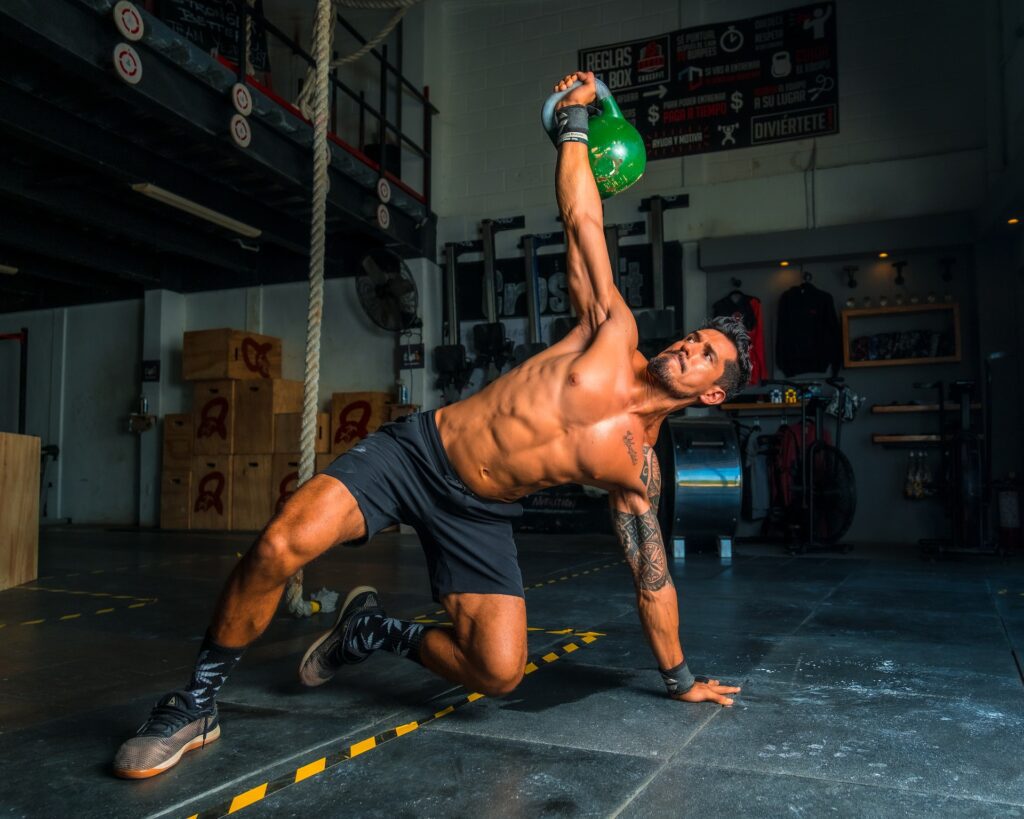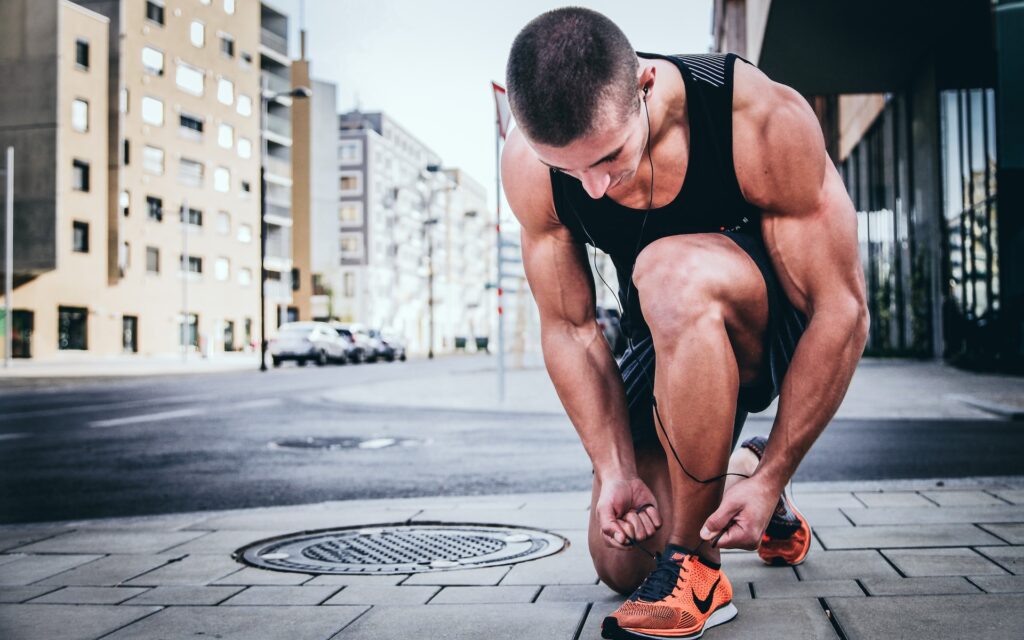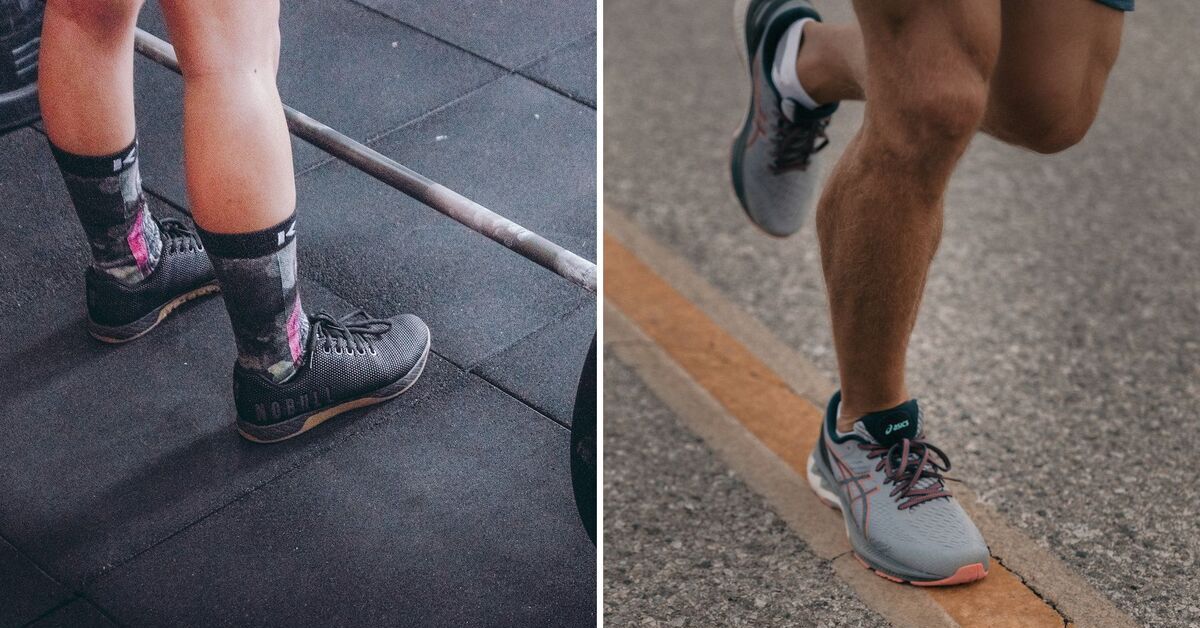Regardless of what type of training you’re doing, the shoes you train in will significantly affect your performance, comfort, and safety. It’s important to choose the proper type of footwear for the activity you’re performing.
Two popular types of fitness footwear are cross-training shoes and running shoes. In addition to being popular, they’re also misused. Many people use them for the wrong types of training.
You might be wondering, “Why is it important to use cross-training shoes vs running shoes for certain types of training?”. To answer this question, we’ll be examining their differences and the types of training they should be used for. We’ll also be examining several popular cross-training and running shoes.
Cross-Training vs CrossFit

Although cross-training and CrossFit have similarities, they aren’t the same thing. To make a distinction between them, it’s important to know their differences.
Cross-training is when an athlete implements training methods and exercises from another sport or fitness activity into their training regimen. For example, a basketball player including swimming in their training regimen would be a form of cross-training.
CrossFit is a fitness program that focuses on strength training and conditioning. It incorporates barbell exercises, bodyweight exercises, cardio, and more.
What Are Cross-Training Shoes?

Cross-training shoes are designed for cross-training. Although cross-training and CrossFit are different activities, cross-training shoes can be worn for both. Cross-training shoes are designed to be used for a wide variety of exercises, making them perfect for both activities. For this reason, cross-training shoes are sometimes called CrossFit shoes.
Cross-training and CrossFit require you to perform different types of exercises in the same workout, which is why cross-training shoes are designed to be versatile. Cross-training shoes provide adequate safety, support, stability, comfort, and durability for many types of exercises.
What Are Running Shoes?

Running shoes are specifically designed for running – hence their name. They can be worn when running on a treadmill, trail, or track. Well-designed running shoes provide adequate comfort and support for running, reducing injury risk and promoting the use of proper running mechanics.
Running shoes shouldn’t be used for strength training, despite the fact that many people use them for it. Running shoes aren’t stable or durable enough for strength training, nor do they provide enough support to prevent strength training injuries. Running shoes should only be used for running.
Differences Between Cross-Training Shoes and Running Shoes

Cross-training shoes and running shoes are designed for different purposes. Although they’re different types of shoes, their differences aren’t always noticeable. In this section, we’ll point out and explain their differences.
Heel-to-Toe Drop
A shoe’s heel-to-toe drop is the difference in height between its heel and toe. Heel-to-toe drop is important because different physical activities require different heel-to-toe drops.
Cross-training shoes typically have a shorter heel-to-toe drop than running shoes, ranging between 0mm and 4mm (some cross-training shoes have a higher heel-to-toe drop than this). This is to enhance stability while performing various types of exercises, such as weightlifting exercises, bodyweight exercises, or exercises that require multi-directional movements. The lower heel-to-toe drop makes it easier to maneuver and is helpful for performing exercises that require you to firmly plant your feet on the ground.
Running shoes’ heels can be flat or elevated, ranging between 0mm and 15mm. They’re designed to accommodate a runner’s foot strike, which can be a toe, midfoot, or heel strike. It’s important for runners to choose the correct heel-to-toe drop for their running style because it’ll affect their running mechanics.
Midsoles
A shoe’s midsole is the cushioning found between its insole, the part of the shoe that touches the bottom of the foot, and outsole, the part of the shoe that touches the ground. The midsoles of cross-training shoes and running shoes are very different.
Cross-training shoes’ midsoles are thin and firm, or non-compressible. Non-compressible midsoles provide a solid base, which is necessary for performing many types of exercises. Cross-training shoes are meant to be versatile, so it’s important that their midsoles accommodate as many exercises as possible.
Running shoes have thicker, compressible midsoles. Compressible midsoles provide comfort and shock absorption for running. Although you can run in cross-training shoes, it isn’t optimal. Running shoes promote proper running mechanics and are more comfortable to run in, especially when running long distances.
Outsoles
A shoe’s outsoles are important because they provide traction, which helps prevent sliding. Different activities require different amounts of traction, so it’s important to wear shoes that are designed for the activity you’re performing.
Cross-training shoes’ outsoles are hard and designed to provide adequate traction for performing various types of exercises, while running shoes’ outsoles are flexible and textured, which is ideal for running.
Weight
Depending on the activity you’re performing, the weight of your shoes can positively or negatively affect your performance. This is one reason it’s important to wear footwear designed for the activity you’re performing.
Running shoes typically weigh less than cross-training shoes. To run properly and efficiently, you should wear lightweight shoes. Cross-training shoes can be used for running short distances during CrossFit or cross-training sessions but shouldn’t be used for running sessions.
Durability
A shoe’s durability is important because it determines how long the shoe will last. Shoes with adequate durability won’t have to be replaced as often. Different training styles require different amounts of durability.
Cross-training shoes tend to be more durable than running shoes. This is because cross-training shoes are meant to be worn during cross-training or CrossFit workouts, which can include sporadic, intense exercises. Running shoes aren’t designed to be as durable as cross-training shoes because the durability demands of running aren’t as high as cross-training and CrossFit.
Lateral Support
Lateral movement refers to side-to-side movements performed during certain physical activities. To reduce the risk of injury while performing lateral movements, it’s important to wear shoes that provide adequate lateral support.
Since cross-training and CrossFit can include exercises that incorporate lateral movements, cross-training shoes are designed to provide lateral support. Typically, running doesn’t involve lots of lateral movement, so most running shoes don’t provide as much lateral support as cross-training shoes.
Recommended Cross-Training Shoes
If you’ve decided that cross-training shoes are ideal for you, you might be considering buying a pair. To assist you in choosing a good pair of cross-training shoes, we’ve included three that we recommend.
Reebok Nano X3
The Reebok Nano X3 is a great all-around cross-training shoe and is good for cross-training or CrossFit.
The X3’s flat, solid base makes it perfect for weight training exercises, such as squats and deadlifts. It has a 7mm heel-to-toe drop, making it a good option if you’re looking for a shoe with slightly elevated heels. Its outsoles provide good traction, whether they’re being used on a weightlifting platform or outdoors. The Nano X3 features a durable, high-quality mesh upper that can tolerate any type of training.
The Reebok X3 can be used for sprints or running short distances during cross-training or CrossFit workouts, but we don’t recommend using it for running long distances. Also, the X3 is somewhat expensive.
Nike Metcon 8
The Nike Metcon 8 is on many “best cross-training shoes” and “best CrossFit shoes” lists, which isn’t surprising.
It has a low heel-to-toe drop (4mm), making it appropriate for a wide variety of exercises. The Metcon 8’s wide, flat heels provide stability, which is ideal for lifting weights. The 8 has a very durable, high-quality design, so it’s perfect for intense training. Its midsoles are made of Nike React foam, providing comfort during sprinting and HIIT workouts.
Like most cross-training shoes, the Nike Metcon 8 falls short when it comes to running. You can run short distances in it, but a running shoe would be better. The Metcon 8 is priced similarly to the Nano X3, so it’s not budget-friendly.
NOBULL Trainer
The NOBULL Trainer is a well-designed cross-training shoe that’s perfect for many different types of exercises. You can use it for anything from lifting weights to rope climbing.
It has a 4mm heel-to-toe drop for stability, lateral and medial guards for support, and durable overall construction. The Trainer has a low stack height, allowing your feet to make a solid connection with the ground when lifting weights. If you’re a CrossFit athlete, you’d be hard-pressed to find a more suitable CrossFit shoe than the NOBULL Trainer.
The NOBULL Trainer has a rigid design, so it might take a few training sessions to break in. Although some lifters run in them, the NOBULL Trainer isn’t good for running. It’s also somewhat pricey, costing roughly the same as the Nano X3 and Metcon 8.
Recommended Running Shoes
Have you decided that running shoes are best for your training style? Below are 3 running shoes we recommend for running workouts and running training.
Brooks Ghost 15
If you’re looking for a comfortable running shoe that’ll enhance your running performance, consider the Brooks Ghost 15.
The Brooks Ghost 15 is very supportive, has a generous heel-to-toe drop (12 mm), and is designed for road running. Because of its high heel-to-toe drop, this shoe is best for runners who heel strike. The Ghost 15’s compression-molded EVA foam provides comfort and shock absorption without being too soft.
The Ghost 15 is heavier than its predecessor, the Ghost 14. If you tend to overstride when you run, the 15’s high heel-to-toe drop can make it worse. For some, this shoe’s cushioning might not be soft enough to use as a daily running shoe.
New Balance FuelCell Rebel v3
The New Balance FuelCell Rebel v3 is used and loved by many runners. If you’re looking for a sleek, secure shoe, it’s a good option.
The FuelCell Rebel v3 has a modest 6mm heel-to-toe drop, which is ideal for those who prefer running shoes with slightly elevated heels. Its midsole is made of FuelCell foam, providing a comfy fit and great shock absorption. The Rebel v3 is more durable than its predecessor, the Rebel v2.
Although the v3 is more durable than the v2, it has poor durability. While the Rebel v3’s outsoles provide decent traction, they don’t provide as much as other running shoes.
Adidas Cloudfoam 2.0
If you’re looking for an affordable women’s running shoe, consider the Adidas Cloudfoam 2.0. It’s very popular, being well-known for its comfort.
The Cloudfoam 2.0’s midsoles are made with Adidas’ Cloudfoam, a reactive EVA foam that provides excellent cushioning and comfort. The shoe is lightweight, making it a good daily running shoe, and it can be used for walking as well. Many people use the Cloudfoam 2.0 as an everyday sneaker to run errands in.
The Adidas Cloudfoam 2.0 has poor durability, which is most likely why it’s inexpensive. It also runs somewhat narrow, which might be a problem for some.
Frequently Asked Questions

Can You Wear Cross-Training Shoes for Running?
Cross-training shoes aren’t ideal for running. You can wear them for running short distances during CrossFit or cross-training workouts, but if you’re only running or will be running long distances, you should wear running shoes. They’ll be safer, more comfortable, and better for your performance.
Can You Wear Running Shoes for CrossFit?
Running shoes shouldn’t be used for CrossFit. They don’t have the lateral support that cross-training shoes have. Since sideways movements are common in CrossFit, running shoes aren’t a good choice. Additionally, running shoes have compressible midsoles, which isn’t ideal for certain exercises. Lifting weights in compressible heels will result in a lack of stability, which can negatively affect your performance.
If You Run and Do Cross-Training, Do You Need Both Types of Shoes?
If you run and cross-train, you should invest in both types of shoes. Cross-training shoes are designed to support and protect you during cross-training, and running shoes are designed to support and protect you during running. This is why it’s best to wear cross-training shoes for cross-training and running shoes for running.
The Bottom Line: Cross-Training Shoes vs Running Shoes
It’s important to use shoes for the activities they’re designed for. Cross-training shoes should be used for cross-training, CrossFit, and lifting weights, and running shoes should be used for running. Using shoes for anything other than their intended use can result in sub-optimal performances and injury.
In this article, we’ve given you a thorough comparison of cross-training shoes and running shoes. We hope you found all the information you were looking for, and we wish you the best as you gear up to advance toward your training goals.
Jay is not just a writer; he’s a seasoned strength enthusiast with two decades of dedicated training under his belt. Whether he’s crafting engaging articles, reviewing cutting-edge equipment, or sharing his personal fitness anecdotes, Jay’s writing resonates with a diverse audience, from seasoned gym enthusiasts to beginners eager to embark on their own transformative fitness paths.






